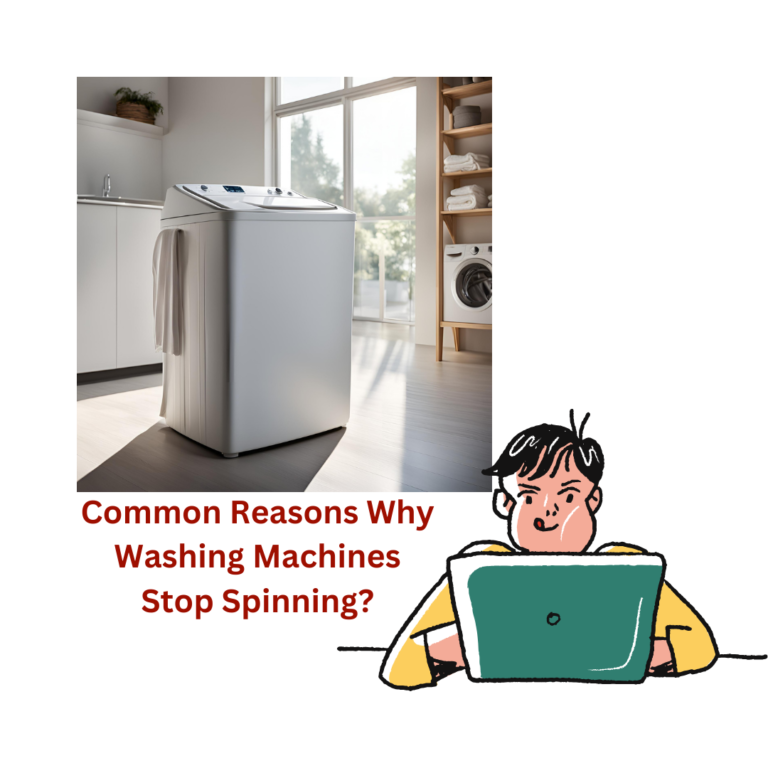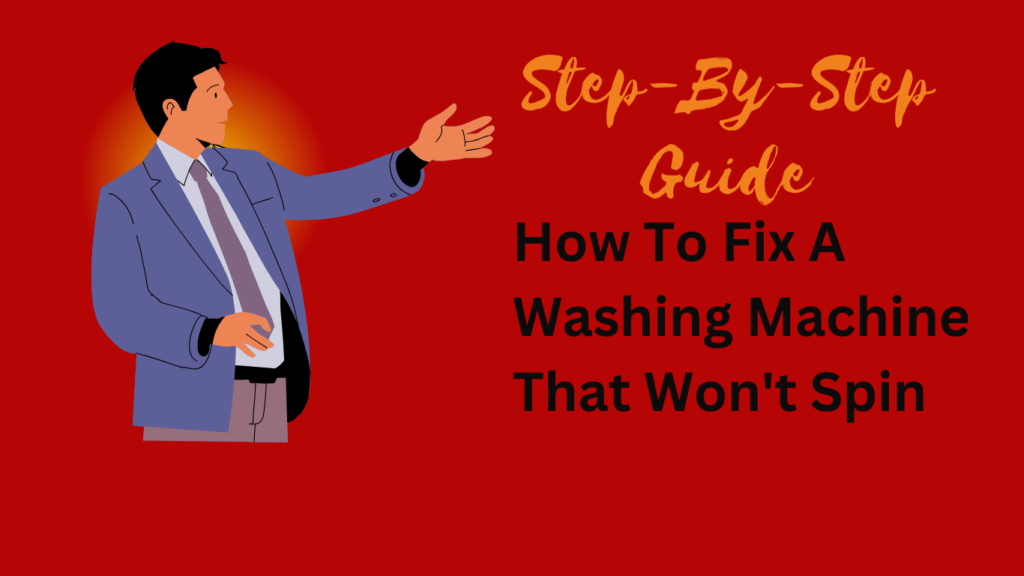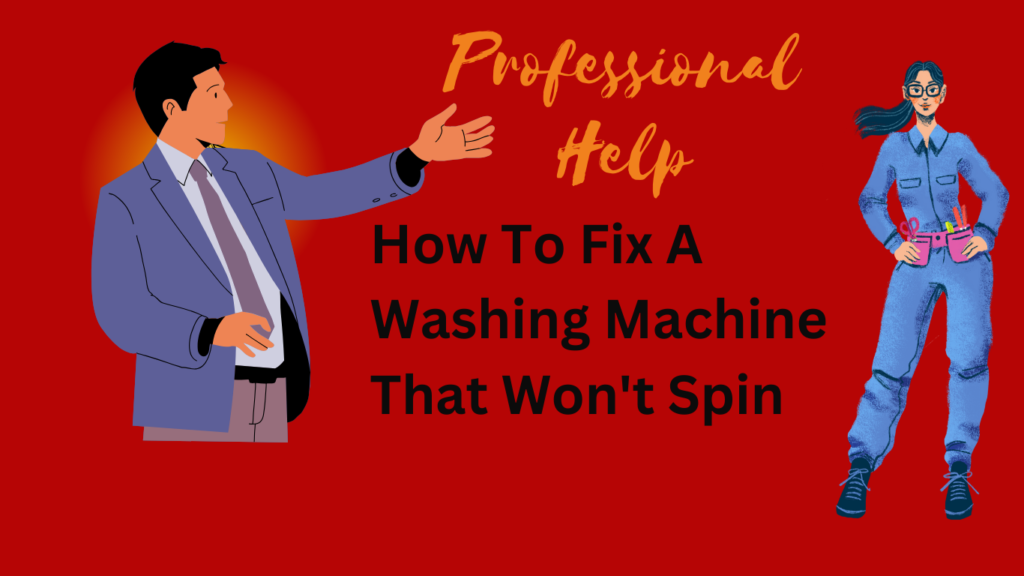Introduction: Understanding the Problem with Your Washing Machine

Washing machines are essential household appliances that save time and effort when doing laundry. However, one of the most common problems users face is when their washing machine won’t spin. This issue can be both frustrating and inconvenient, especially when you’re in the middle of a laundry cycle. Understanding why a washing machine refuses to spin is the first step toward fixing the issue.
In this blog, we’ll guide you through how to fix a washing machine that won’t spin. You don’t necessarily need to be a professional to troubleshoot the problem. Many issues can be identified and resolved at home with a little bit of knowledge and some basic tools. We’ll cover everything from common causes to step-by-step troubleshooting techniques and maintenance tips.
The spin cycle is crucial because it removes excess water from your clothes, speeding up the drying process. When your machine stops spinning, it could be due to an unbalanced load or more complex problems like a broken drive belt or faulty lid switch. Regardless of the cause, knowing how to fix a washing machine that won’t spin can save you time, money, and frustration.
Table of Contents
Briefly explain why a washing machine may stop spinning:
A washing machine may stop spinning for several reasons, and understanding these causes is key to knowing how to fix a washing machine that won’t spin. One of the most common reasons is an unbalanced load. When the laundry inside the drum is not distributed evenly, the machine may automatically stop spinning to prevent damage. Heavy items like blankets or towels can cause the machine to go off balance, halting the spin cycle.
Another reason could be a faulty lid switch. In many top-load washing machines, the lid switch is a safety mechanism that prevents the machine from spinning when the lid is open. If the switch is malfunctioning, the washing machine might think the lid is open, even when it’s closed, causing the machine to stop spinning.
A worn-out drive belt is another possible cause. The drive belt is responsible for turning the drum during the spin cycle. Over time, it can become loose, frayed, or broken, which prevents the drum from spinning effectively.
Additionally, clogged drainage can stop the machine from spinning. If the drain pump or filter is clogged, the machine won’t be able to drain water properly, which in turn stops the spin cycle. Ensuring the drainage system is clear is essential for a fully functioning spin cycle.
Finally, motor or motor coupling issues can also lead to a washing machine that won’t spin. The motor powers the drum’s rotation, and if it’s damaged, the spin cycle won’t initiate.
By understanding these common causes, you can take steps toward how to fix a washing machine that won’t spin, saving time and avoiding unnecessary repairs.

Common Reasons Why Washing Machines Stop Spinning?
There are multiple reasons why a washing machine may stop spinning. Below are some of the most common causes you might encounter when diagnosing how to fix a washing machine that won’t spin.
- Unbalanced Load: Washing machines are designed to spin smoothly, but if the load inside the drum is too heavy or unevenly distributed, it can throw the machine off balance. This usually causes the machine to stop spinning to prevent damage.
- Faulty Lid Switch: The lid switch is a safety feature that prevents the machine from spinning when the lid is open. If this switch is broken or malfunctioning, the machine won’t recognize that the lid is closed and, therefore, won’t spin.
- Worn-Out Drive Belt: The drive belt is responsible for rotating the washing machine drum. If it’s worn out, frayed, or broken, the drum won’t spin, and you’ll need to replace it.
- Clogged Drain Pump: A washing machine needs to drain properly to spin effectively. If the drain pump or filter is clogged with lint, dirt, or other debris, it can prevent the machine from spinning.
- Motor or Motor Coupling Issues: The motor is what drives the washing machine’s spinning action. If the motor or motor coupling is damaged, the machine may stop spinning entirely.
- Electrical Problems: Sometimes, the issue could be an electrical one, such as a blown fuse, tripped circuit breaker, or faulty wiring that prevents the spin cycle from initiating.
Identifying which of these issues is affecting your washing machine is key to knowing how to fix a washing machine that won’t spin.
List and describe the main causes:-

When your washing machine stops spinning, it’s essential to identify the main causes before addressing how to fix a washing machine that won’t spin. Here’s a list of the most common issues:
- Unbalanced Load- One of the most frequent reasons a washing machine won’t spin is an unbalanced load. If heavy items like towels, blankets, or bedding are grouped on one side of the drum, it can throw the machine off balance. Many modern washing machines are equipped with sensors to detect this imbalance and will stop spinning to prevent damage.
- Lid Switch Failure- In top-loading washing machines, the lid switch is a safety mechanism that prevents the drum from spinning if the lid is open. If this switch malfunctions, the machine may incorrectly sense that the lid is open, stopping the spin cycle altogether. Testing and replacing the lid switch can resolve this issue.
- Broken Drive Belt- The drive belt is responsible for spinning the drum. Over time, the belt can become loose, frayed, or break completely, rendering the washing machine unable to spin. Inspecting and replacing a worn-out belt is a crucial step in fixing the problem.
- Drainage Problems- If the machine is not draining properly, it won’t spin. Clogged filters or drain pumps can prevent water from leaving the drum, causing the spin cycle to halt. Cleaning out any obstructions from the drainage system can restore normal function.
- Motor or Coupling Issues- A faulty motor or worn-out motor coupling can lead to a washing machine that won’t spin. The motor powers the drum’s rotation, and if it’s defective, the spin cycle won’t engage. Replacing the motor or its coupling may be necessary.
Understanding these causes is the first step in learning how to fix a washing machine that won’t spin, allowing you to troubleshoot and address the issue effectively.
Provide a practical guide on how to diagnose and fix basic issues:-
If you’re facing the frustrating problem of a washing machine that won’t spin, knowing how to fix a washing machine that won’t spin can save you time and money. Here’s a practical guide to diagnosing and fixing some basic issues:
- Check the Load Balance- Start by checking if the washing machine is unbalanced. Uneven loads, particularly with heavy items like towels or blankets, can stop the spin cycle. Rearrange the items in the drum to distribute the weight more evenly, and run the spin cycle again to see if this resolves the issue.
- Inspect the Lid Switch- In top-loading washers, the lid switch may be the culprit. The machine won’t spin if the switch is faulty or broken because it believes the lid is open. To check, press the switch manually when the lid is open. If the machine begins to spin, the switch is functioning. If not, you may need to replace the lid switch.
- Examine the Drive Belt- Next, unplug the washing machine and remove the back panel to inspect the drive belt. If the belt is loose, worn, or broken, the drum won’t spin. Replacing the belt is usually straightforward with a few simple tools. Ensure the belt is tight and in good condition to allow proper spinning.
- Look for Drainage Issues- If water remains in the drum, the washing machine won’t spin. Inspect the drain hose for blockages or kinks, and clean the filter and pump to ensure there’s no obstruction. If the drainage system is clogged, clearing it should allow the machine to spin.
- Test the Motor and Coupling- Finally, if the drum doesn’t spin despite these fixes, it may be a motor or motor coupling issue. A faulty motor can prevent spinning, and you may need to call a technician for professional repair.
Following these steps can guide you through how to fix a washing machine that won’t spin, helping to restore your appliance’s functionality quickly.
Step-by-Step Guide to Troubleshoot a Non-Spinning Washing Machine:-

If you’re dealing with a washing machine that won’t spin, follow this step-by-step troubleshooting guide to resolve the issue.
- Turn Off the Power: Always unplug the washing machine before attempting any troubleshooting or repairs. Safety first!
- Check for an Unbalanced Load: Open the machine and check if the laundry is distributed evenly. Sometimes heavy items like towels can clump together and cause the drum to go off balance. Rearrange the clothes and try running the spin cycle again.
- Inspect the Lid Switch: If your washing machine is a top-loader, listen for a click when you close the lid. If there’s no click, the lid switch might be faulty. Test it with a multimeter to check for continuity. If it’s broken, you’ll need to replace it.
- Check the Drive Belt: Remove the access panel on your washing machine and inspect the drive belt. If it looks frayed or loose, it could be the cause of your problem. Replace it if necessary.
- Test the Drainage System: Remove the filter and inspect it for clogs. If the filter or pump is blocked, clean it out. Also, check the drain hose for any kinks or obstructions.
- Test the Motor Coupling: If the motor coupling is worn or broken, it will prevent the drum from spinning. Check the coupling between the motor and transmission to see if it needs replacing.
By following these steps, you can figure out how to fix a washing machine that won’t spin without needing professional assistance.
How to Check and Fix the Lid Switch?
The lid switch is an integral part of your washing machine’s safety system, ensuring that the drum doesn’t spin when the lid is open. If the lid switch is malfunctioning, your machine may not recognize that the lid is closed, preventing the spin cycle from starting.
Here’s how to fix a washing machine that won’t spin if the lid switch is the culprit:
- Locate the Lid Switch: In most top-loading washing machines, the lid switch is located near the door hinge. You’ll typically need to remove the control panel or top of the machine to access it.
- Test the Lid Switch: Use a multimeter to test for electrical continuity. Set the multimeter to the lowest ohms setting, and place the probes on the switch terminals. If the multimeter shows no continuity, the switch is faulty and needs replacement.
- Replace the Lid Switch: Disconnect the old switch by unplugging the wires connected to it. Install the new switch by reversing this process. Once replaced, close the lid and try running a spin cycle.
Knowing how to fix a washing machine that won’t spin by addressing the lid switch can solve the problem in many cases.
Inspecting the Drive Belt and Motor Coupling

If your washing machine’s drum isn’t spinning, the drive belt or motor coupling may be to blame. Both components are responsible for transmitting power from the motor to the drum, enabling it to rotate.
- Inspect the Drive Belt: The drive belt is usually located at the bottom of the machine, attached to the drum and motor. Remove the back panel of the washing machine to access it. If the belt is frayed, loose, or broken, it won’t transfer power to the drum.
- Replacing the Drive Belt: If you’ve identified that the drive belt is the issue, replacing it is straightforward. Remove the old belt and loop the new one around the drum and motor pulley. Tighten any tension screws if necessary.
- Check the Motor Coupling: The motor coupling connects the motor to the transmission. If it’s broken or worn out, the machine won’t spin. To inspect the motor coupling, you’ll need to disassemble part of the machine and locate the connection between the motor and drum. If damaged, replace it.
Knowing how to address these components is crucial when learning how to fix a washing machine that won’t spin.
Addressing Drainage Problems: Clogged Pump or Filter
Drainage issues are another common cause of a washing machine that won’t spin. If the water isn’t draining properly, the machine will automatically stop the spin cycle. Here’s how to fix a washing machine that won’t spin due to drainage issues:
- Check the Drain Hose: Ensure the hose isn’t kinked or clogged. Disconnect the hose from the machine and blow air through it to see if it’s clear.
- Inspect the Drain Pump: If the pump is clogged with debris, the machine won’t drain properly. Locate the pump and check for blockages.
- Clean the Pump Filter: Many washing machines have a filter that catches lint and small objects before they reach the pump. Clean this filter regularly to ensure proper drainage.
By addressing drainage problems, you can restore your machine’s spin cycle.

When to Call a Professional for Help?
Sometimes, even after troubleshooting, you may not be able to fix the problem on your own. Here’s when it’s time to call in a professional to help with how to fix a washing machine that won’t spin:
- Electrical Issues: If there’s a problem with the wiring, motor, or control board, it’s best to let a technician handle the repairs.
- Complex Mechanical Failures: If the transmission or internal components like the bearings are worn out, these issues may require specialized tools and expertise.
- Warranty Concerns: If your machine is under warranty, attempting repairs on your own may void it. Contact the manufacturer or a certified technician instead.
Knowing when to seek professional assistance ensures that you don’t make the problem worse.
Preventing Future Spin Issues: Maintenance Tips:-

Preventing future spin problems is easier than fixing them. Here are some maintenance tips to help you avoid asking how to fix a washing machine that won’t spin in the future:
- Balance the Load: Always distribute laundry evenly in the drum to avoid overloading the machine and causing imbalance.
- Clean the Pump and Filter Regularly: Keeping the drainage system clear will prevent clogs that stop the machine from spinning.
- Inspect the Belt Annually: Check the drive belt once a year to ensure it’s in good condition and doesn’t need replacement.
- Check the Lid Switch: Periodically test the lid switch to ensure it’s functioning correctly.
By following these maintenance tips, you can ensure your washing machine runs smoothly for years to come.
Conclusion: Fixing Your Washing Machine for Long-Term Efficiency

Learning how to fix a washing machine that won’t spin can save you from the hassle of laundry pileups and expensive repairs. Whether it’s an unbalanced load, a faulty lid switch, or a worn-out drive belt, many spin cycle issues can be resolved at home with the right knowledge and tools. However, when in doubt, don’t hesitate to call a professional to avoid further complications.
By taking care of your washing machine and following regular maintenance practices, you can prevent future spin issues and ensure your appliance continues to work efficiently for years.
- You might be interested in reading this post as well:
- Top 5 Washing Machines With Agitators IN 2024

Pingback: Best Washing Machines Under 10000 In 2024 -